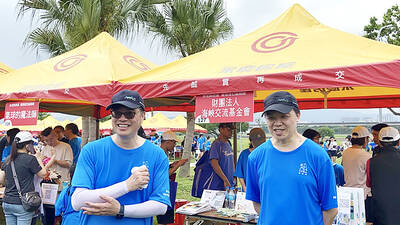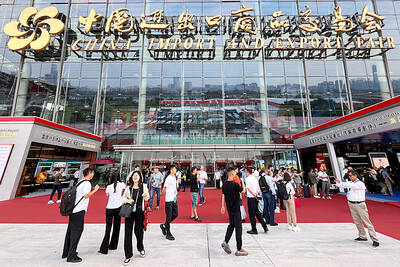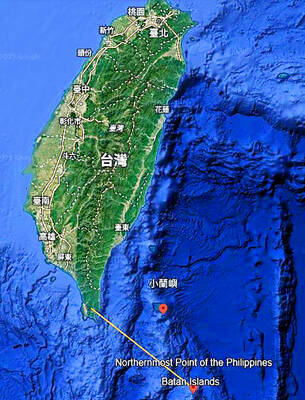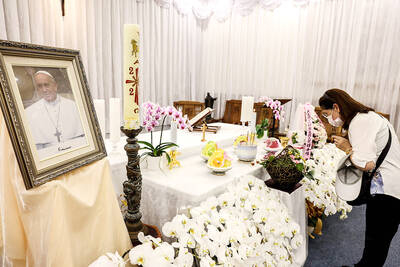Lighter lunches, less alcohol and even streamlined cutlery are on the menu on Asian airlines as they shed excess weight in scores of little ways in a bid to cut down escalating fuel costs.
With every gram carried on board equating to fuel, airlines are taking a closer look at what’s on board and making some inventive changes to cut their fuel costs — some which passengers may notice, others they won’t.
These include using lighter cutlery with in-flight meals, cutting down on the amount of wine, beer and water carried on board and even ditching heavyweight magazines in favor of more light-weight reading — literally.
Japan’s largest airliner Japan Airlines Corp has shaved 2.5kg per flight by introducing spoons and forks that are 2 grams lighter for its non-business class passengers.
Its in-flight audio programs have also been made a few pages thinner by squashing Japanese and English text side-by-side.
However, the most weight being lifted is in the cargo section where JAL has introduced glass fiber containers to cut some 26kg per load.
All Nippon Airways Co, meanwhile, have decided to stock its alcohol section with quarter bottles of wine instead of full bottles, but has assured passengers that this will not lead them to run out mid-route, insisting: “We had loaded too much before.”
The company has also changed seats on domestic flight planes — introducing a lighter carbon fiber seat frame, which reportedly will save the airline 40,000 liters per aircraft each year.
For passengers it has brought welcomed widened leg-room, a spokesman said, although the downside is reduced “cushion” in their seats.
Other airlines are taking more short-term measures.
The Times of India reported that Jet Airway’s low cost option JetLite has stopped serving free water, sweets and snacks to reduce weight, while rivals IndiGo, Spice Jet and Deccan have also stopped selling snacks. Spice-Jet and Air India’s domestic flights are now sweet-free.
Singapore Airlines has already introduced lightweight carts and service-ware for meals on board its new A380, the world’s largest passenger jet — a move which will eventually be extended to other aircraft.
“We’re also eliminating heavy magazines and opting for lightweight reading instead,” said a spokesperson, although he declined to reveal the publications that would be scrapped.
Thai Aiways International (THAI) is seeking to reduce its weight load by skimping on fuel reserves, a policy that might cause some jitters among passengers although the airline insists the policy is in keeping with European safety standards.
The national carrier is aiming to halve its contingency fuel reserves as part of its weight-loss measures.
One THAI executive said such a move on the Bangkok-London route, for instance, would mean shedding about 2 tonnes in weight — amounting to a fuel reduction that would save US$800.
In the Philippines, airlines have taken less innovative measures to cut weight. Flagship carrier Philippine Airlines has already limited free checked in baggage to 23kg on its North American service, while domestic carrier Air Philippines has cut its daily service from Manila to three southern cities.
Others are looking to more expensive, long-term methods such as replacing their fuel guzzling aircraft with models that are more fuel efficient.
The same move is being employed by Hong Kong’s flagship airline Cathay Pacific(國泰航空), which sees fuel-efficient aircraft and route management as the key to saving fuel.
The airline posted a 125 percent drop on net profits for the first half of the year compared to the year before, blaming the relentless increase in fuel prices which it said rose 60 percent to US$132 per barrel over those six months.
In May, the airline took delivery of the first of six Boeing 747-400ERFs (Extended Range Freighters) that benefit from higher fuel efficiency.
“These new, efficient aircraft are going to help us get through this crisis,” said Cathay’s chief executive Tony Tyler, while emphasizing that the airline would not do anything to lessen the product.
“We’re asking our passengers to pay more so we don’t want to give them less. We need them to fly Cathay Pacific and keep coming back,” he said.
But the prize for the most “innovative” weight-watching has to go to India’s Kingfisher, which has admitted saving pennies on their fuel bill by reducing the amount of washroom water carried on board.
They are encouraging passengers not to “spend a penny” (visit the washroom).
“Our planes are flying with half or less than half-filled water tanks as it lightens the load and reduces fuel consumption. And we are not the only airline doing this,” a Kingfisher airline senior official told the Daily Telegraph.
With experts claiming that every flush at 30,000 feet saves enough fuel to power a car for 10km, this move is not as silly as you would first think. As the well-worn adage goes: “Every little bit helps.”

SECURITY: As China is ‘reshaping’ Hong Kong’s population, Taiwan must raise the eligibility threshold for applications from Hong Kongers, Chiu Chui-cheng said When Hong Kong and Macau citizens apply for residency in Taiwan, it would be under a new category that includes a “national security observation period,” Mainland Affairs Council (MAC) Minister Chiu Chui-cheng (邱垂正) said yesterday. President William Lai (賴清德) on March 13 announced 17 strategies to counter China’s aggression toward Taiwan, including incorporating national security considerations into the review process for residency applications from Hong Kong and Macau citizens. The situation in Hong Kong is constantly changing, Chiu said to media yesterday on the sidelines of the Taipei Technology Run hosted by the Taipei Neihu Technology Park Development Association. With

CARROT AND STICK: While unrelenting in its military threats, China attracted nearly 40,000 Taiwanese to over 400 business events last year Nearly 40,000 Taiwanese last year joined industry events in China, such as conferences and trade fairs, supported by the Chinese government, a study showed yesterday, as Beijing ramps up a charm offensive toward Taipei alongside military pressure. China has long taken a carrot-and-stick approach to Taiwan, threatening it with the prospect of military action while reaching out to those it believes are amenable to Beijing’s point of view. Taiwanese security officials are wary of what they see as Beijing’s influence campaigns to sway public opinion after Taipei and Beijing gradually resumed travel links halted by the COVID-19 pandemic, but the scale of

A US Marine Corps regiment equipped with Naval Strike Missiles (NSM) is set to participate in the upcoming Balikatan 25 exercise in the Luzon Strait, marking the system’s first-ever deployment in the Philippines. US and Philippine officials have separately confirmed that the Navy Marine Expeditionary Ship Interdiction System (NMESIS) — the mobile launch platform for the Naval Strike Missile — would take part in the joint exercise. The missiles are being deployed to “a strategic first island chain chokepoint” in the waters between Taiwan proper and the Philippines, US-based Naval News reported. “The Luzon Strait and Bashi Channel represent a critical access

Pope Francis is be laid to rest on Saturday after lying in state for three days in St Peter’s Basilica, where the faithful are expected to flock to pay their respects to history’s first Latin American pontiff. The cardinals met yesterday in the Vatican’s synod hall to chart the next steps before a conclave begins to choose Francis’ successor, as condolences poured in from around the world. According to current norms, the conclave must begin between May 5 and 10. The cardinals set the funeral for Saturday at 10am in St Peter’s Square, to be celebrated by the dean of the College